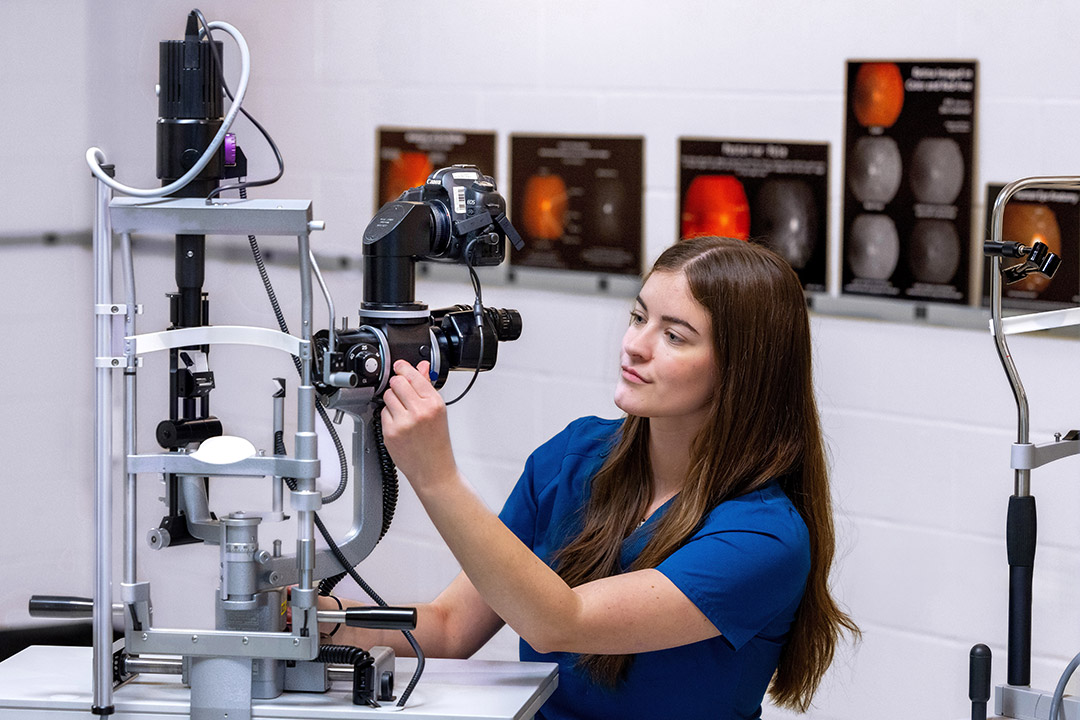Paige Wright extends her education through a summer internship with world-renowned ophthalmic photographers

Carlos Ortiz/RIT
Taking two ophthalmic imaging courses at RIT solidified Paige Wright’s decision to pursue a career as an ophthalmic photographer.
When Paige Wright changed her major to photographic sciences, she thought photo microscopy was an appealing niche to pursue. However, ironically, her view of the field was narrow.
She anticipated working behind a traditional microscope—and she certainly didn’t think scrubs would become part of her work tools—but enrolling in two ophthalmic imaging courses as a third-year student opened her eyes to a new career path.
Ophthalmic photography is a highly specialized form of medical imaging dedicated to the study and documentation of disorders of the eyes. These visual records assist medical professionals in diagnosing ocular conditions and monitoring disease progressions and can support research and education.
“I’m still using microscopes to make images, just in a different way than I thought,” said Wright, a fourth-year student from Wilmington, Del. “I’ve always had a fascination with eyes. For such a small part of your body, they are so important and play such a huge role in your everyday life.”
After graduation, Wright will travel to New York City for an internship at Vitreous Retina Macula Consultants of New York (VRMNY). As an ophthalmic photographer, she will work alongside accomplished doctors like Richard F. Spaide.
Spaide is one of the most cited retina specialists in ophthalmological literature, having authored over 300 peer-reviewed articles on ophthalmology. Learning directly from an expert like Spaide was an opportunity Wright couldn’t pass on.
“Dr. Spaide is a world-renowned retina specialist. Even though I had an internship last year at Flaum Eye Institute and felt confident I would get a job at home, I knew this experience would make me a more valuable candidate and could help me to get a job almost anywhere,” said Wright.
The internship at VRMNY came to Wright through alumni connections. Sarah Armstrong ’05 (biomedical photographic communications) contacted Christye Sisson about the opportunity with Dr. Spaide during an ophthalmic imaging conference. Sisson, director of RIT’s School of Photographic Arts and Sciences, shared the opportunity with Nanette Salvaggio, who then encouraged Wright to apply.
Salvaggio, director of the undergraduate photographic sciences program, met Wright during her first class at RIT, bright and early on a Monday morning. Salvaggio said watching Wright grow from a “reserved” first-year student into a highly accomplished graduate was rewarding. Specifically, she noted Wright’s “exemplary leadership, characterized by her proficiency, professionalism, and unwavering dedication.”
“While we facilitated her introduction to Dr. Spaide, it was her composure and the extensive knowledge she acquired during her time with us that ultimately secured this remarkable opportunity,” said Salvaggio. “She serves as an inspiration to others, fostering a collaborative and productive learning environment.”
Once Wright completes her summer internship, she plans to move back home to Delaware to seek a position at a hospital or large private practice. In the long term, she aspires to get more involved with research, potentially returning to academia to lead an ophthalmic imaging department.









